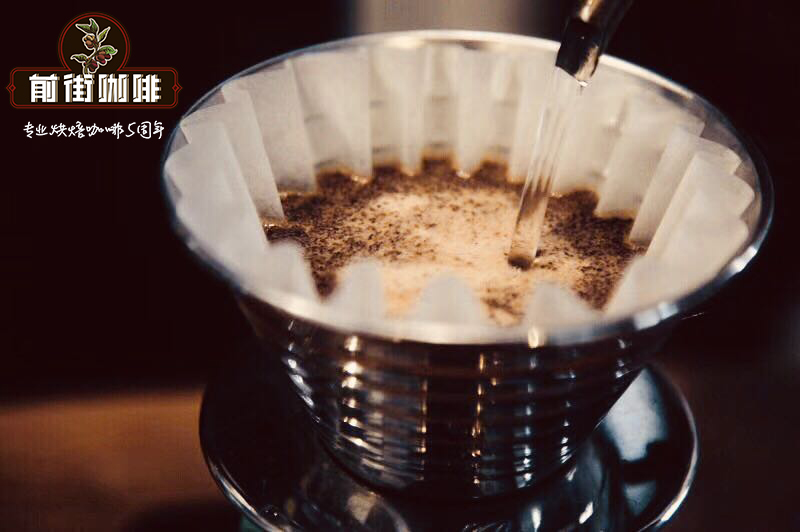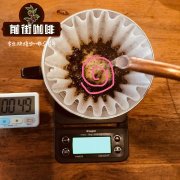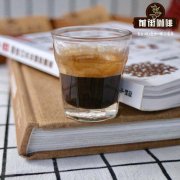The difference between washing and tanning of Kenyan coffee beans how to drink Kenyan coffee with different treatments?

Professional coffee knowledge exchange more coffee bean information please follow the coffee workshop (Wechat official account cafe_style)
[Kenyan Coffee Bean Haniyeh Manor French missionary bourbon sunburn]
Introduction to Solar treatment
This Kenyan coffee bean is treated in the sun, adding solidity and sweetness to the already rich and sour bourbon in the process of delicate sun exposure. With a limited number of sun batches, this coffee is completely dependent on the natural climate.
Analysis of baking of Kenyan coffee beans in the sun
The bean density is medium, the baking power is medium, and the heating rate of growing beans is faster during the baking process, so we should reduce the firepower at 150℃, 160℃ and 170℃ to prolong the Mena reaction time and prevent the beans from heating up too much. The first explosion starts at about 8 minutes and 15 seconds at 186 ℃. At the same time, the firepower is reduced and the throttle is opened to develop the flavor. 194 ℃ at 2 minutes.
Roaster Yangjia 600g semi-direct fire (baking capacity 300g)
The furnace temperature is preheated to 170℃ into the pot, the throttle is opened at 3j30s, fire is fired, the firepower is adjusted 140,the throttle is unchanged, the temperature recovery point is 1`28``, the firepower is reduced to 110and the throttle is opened to 4 at 140℃. 4`20` turns yellow, the smell of grass disappears, enters the dehydration stage, the firepower is reduced to 90, and the throttle is kept at 4. The firepower was reduced to 90, 70 and 50 again at 150℃, 160℃ and 170℃.
After dehydration, the bean surface appears wrinkles and black markings, and the taste of toast changes to coffee, which is a prelude to an explosion. Pay attention to the sound of an explosion. When the blast starts at 8`13``, the throttle is all open for 5, and the firepower is adjusted to 30 at the same time. After an explosion, the development time is 2 minutes, and put into the pot at 194 ℃.
This coffee has a good flavor, but the defect rate is high. Please choose it carefully before baking. Dry aroma with sun fermentation, dried fruit and vanilla, sipping can drink caramel, vanilla, comprehensive fruit, solid juice, finish with berries, strong jackfruit, coffee flowers. The overall performance has the wild regional flavor of Africa, which is suitable for sipping and tasting slowly, and the complex aroma is difficult to give up.
Basking data of Kenyan coffee beans in the sun
Recommended cooking method: hand flushing
Degree of grinding: 3.5 (Fuji R440, Japan)
Water temperature: 90 ~ 91 °C
V60 filter cup, 15g powder, grinding 3.5.The ratio of water to powder is close to 1:15
Steaming in 30 grams of water for 30 seconds
Segment: water injection to 120ml cut off, slow water injection to 225ml
That is, 30-120-75, the total extraction time is about 2 minutes.
Other suggestions for trickling extraction:
Normal pressure, recommended grinding degree of 3.5-4 / water temperature 90 °C
Philharmonic pressure, recommended 2.5 grinding degree, water temperature 90 °C
Hand punch: 3.5 degree of grinding, water temperature 91 °C
3.5 Grinding-90 degrees water temperature
[wash Kenyan coffee beans AA Carlo Goto]
Washing treatment of coffee beans in Kenya
[Kenyan-style 72-hour fermentation water washing treatment] originated in Kenya and adopted the cyclic repeated treatment method of washing after fermentation, which was made after the same day of harvest to select the best quality cherries for peeling and fermentation. the fermentation time is 24 hours, and clean river water is used after 24 hours.
Then, it was fermented again with clean river water for 24 hours, then washed, and repeated 3 times for 72 hours, so it was called Kenyan 72-hour fermentation water washing treatment, abbreviated as [K72].
The Kenyan coffee bean washing tank has two layers, the process is as follows: in the evening, the defective coffee fruit is removed, the peel is removed, and then the sticky shell beans are removed, most of the pectin is removed, and then it is fermented twice in the lower clean pool, and then the recycled water is updated every few hours to avoid breeding mold; then it is introduced into the washing ditch to remove the residual pectin.
With so much industrial waste, no wonder Kenyan coffee beans taste so delicate.
Analysis of washed raw beans of Kenyan coffee
The coffee grade of Niya is divided into seven grades according to the size of coffee beans and six grades according to the taste. The best coffee in Kenya is bean berry coffee (PB), followed by AA++, AA+, AA, AB and so on. The fine coffee is shiny, delicious and slightly alcoholic. "Kenya AA" is particularly well received in terms of taste.
Kenya's raw beans are also graded according to the size of beans:
The best coffee grade in Kenya is bean berry coffee (PB), followed by AA, AB and so on.
PB (PeaBerry) round beans: this is the grading for small round beans. This means that there is only one stone in the coffee fruit, not the common two kernels.
E: that is, "elephant beans", the size is very large, and the output is relatively small.
AA: this is a more common grade. Coffee beans are larger in size and have a particle size higher than 18 mesh or 7.22mm. This kind of beans usually get the highest price.
AB: this grade coffee bean combines A (particle size 16 mesh or 6.80mm) with B (particle size 15 mesh or 6.20mm); accounts for about 30 per cent of Kenya's annual coffee production.
C: this grade is lower than that of AB and is rare in high-quality coffee.
TT: a lower grade, mostly consisting of small beans removed from AA, AB, and E beans. If screened by density, the lightest beans are usually TT.
T: the lowest grade, usually made up of coffee crumbs and broken beans.
MH | ML: these two abbreviations stand for Mbuni Heavy and Mbuni Light. Mbuni means coffee beans that are sun-treated. These beans are considered to be of low quality, usually with immature or overripe coffee beans, and the price is quite low. This grade accounts for about 7% of Kenya's annual coffee production.
Variety
Kenyan coffee varieties: two Kenyan varieties have particularly attracted the attention of the boutique coffee industry: SL-28 and SL-34. This is by Guy of the Scott Lab (Scott Laboratories). The research project led by Guy Gibson produced two of the 40 experimental varieties, but these varieties are susceptible to leaf rust.
The bourbon variants (SL-28) and (SL-34) have always been the winners of the expert cup test Narobi auction. The Kenyan raspberry flavor comes from these two beans-- especially (SL-28)-- is the consensus of experts. But although his flavor is good, his production capacity and disease resistance is not good.
Kenya spares no effort in developing varieties that are resistant to leaf rust.
Ruiru11 is the first variety to be approved successfully by the Kenyan Coffee Council, even though boutique coffee buyers are lukewarm about the variety. In recent years, the Coffee Committee has launched another variety called Batian. The quality seems to have improved, and people are optimistic about its future cup performance.
Baking Analysis of washed Kenyan Coffee beans
On the left-hand side is Kenya SL28
The first is from the nyeri producing area, washing treatment, varieties are sl28, sl34.
The rating is AA:
AA refers to the particle size of raw beans: the general size is not through sieve 18 (the mesh hole is 7.22mm).
The baking process is as follows:
Roaster Yangjia 600g semi-direct fire
The amount of beans is 300g,
Temperature recovery point: 1: 28, 101.8 °c
Yellowing point: 5 minutes 46, 151.2 °c
One explosion: 8 points, 21, 175.3 °c
Out of the oven: 9 minutes 51, 186.7 °c
One explosion came out of the furnace
Baking degree: medium and shallow baking
After baking for 12 hours, the cup test: the entrance is fresh and clean black brine, nectarine acidity, good permeability, the acidity will bring corn sweet after the temperature falls, the whole is very refreshing.
The hardness of this raw bean is not very high, so it is also chosen to enter the bean at a medium and low temperature, and then the fire and throttle open after the temperature point to maximize its permeability, and the baking degree of the choice is also shallow.
From the appearance of raw beans, you can easily see the difference between AA and PB. PB (peaberry): we often call small round beans, usually a coffee fruit is made up of two coffee beans, and a round bean is a coffee fruit with only one bean in it.
The baking process is as follows:
Roaster Yangjia 600g semi-direct fire
The amount of beans is 550g,
Temperature recovery point: 1: 38, 102.0 °c
Yellowing point: 5 minutes 11, 151.6 °c
First explosion: 8: 00, 179.9 °c
Out of the oven: 10 minutes 10, 189.3 °c
The furnace came out as soon as the tail burst.
Baking degree: shallow and medium baking
After baking for 12 hours, the cup test: the entrance of the strong round cherry pulp sour, rich sweet and sour juicy, the aftertaste of brown sugar is sweet.
Analysis of washed Kenyan Coffee beans
Recommended cooking methods: siphon, hand flushing
Degree of grinding: 3.5 (Fuji R440, Japan)
Water temperature: 91 °C
V60 filter cup, 15g powder, water temperature 95 degrees, grinding 3.5, ratio of water to powder close to 1:15
Steaming in 30 grams of water for 30 seconds
Segment: water injection to 110ml cut off, slow water injection to 225ml
That is, 30-110-85
Specific hand flush [Kenya AA] Karoguto: 15g powder, medium and fine grinding (small Fuji ghost tooth knife 3.5grind), v60 filter cup, 90-91 degrees water temperature, the first water injection 30g water, conduct 30s steaming, injection to 110g water cut off, wait for powder bed water to half of water injection, slow water injection until 225g water quantity, tail section do not, gouache ratio 1:15, extraction time 2:12.
Other suggestions for trickling extraction:
Normal pressure, recommended grinding degree of 3.5-4 / water temperature 90 °C
Philharmonic pressure, recommended 2.5 grinding degree, water temperature 88 °C
Siphon: 4 degree of grinding, water temperature 91 °C
Qianjie coffee: Guangzhou bakery, the store is small but a variety of beans, you can find a variety of unknown beans, but also provide online store services. Https://shop104210103.taobao.com
Important Notice :
前街咖啡 FrontStreet Coffee has moved to new addredd:
FrontStreet Coffee Address: 315,Donghua East Road,GuangZhou
Tel:020 38364473
- Prev

Flavor characteristics of Kenyan Coffee beans Teaching Diagram of Coffee extraction steps in Kenya
Professional coffee knowledge exchange more coffee bean information please follow the coffee workshop (Wechat official account cafe_style) Kenya boutique coffee beans, inheriting the fascinating characteristics of the African continent's outstanding boutique representative Yega Xuefei, full of wild land and hot sunshine atmosphere. But it also shows that it has something to do with Yejiaxue.
- Next

How do Kenyan coffee beans do Italian concentrate? Can Kenyan coffee beans do SOE?
Professional coffee knowledge exchange more coffee bean information Please pay attention to the coffee workshop (Wechat official account cafe_style) SOE represents single-origin espresso, although it is not necessarily the same as fine coffee, if you choose single-origin coffee beans with easy to identify flavor as SOE, you can produce a typical espresso with unique flavor. For example, Yega's typical citrus flavor, Kenny
Related
- Detailed explanation of Jadeite planting Land in Panamanian Jadeite Manor introduction to the grading system of Jadeite competitive bidding, Red bid, Green bid and Rose Summer
- Story of Coffee planting in Brenka region of Costa Rica Stonehenge Manor anaerobic heavy honey treatment of flavor mouth
- What's on the barrel of Blue Mountain Coffee beans?
- Can American coffee also pull flowers? How to use hot American style to pull out a good-looking pattern?
- Can you make a cold extract with coffee beans? What is the right proportion for cold-extracted coffee formula?
- Indonesian PWN Gold Mandrine Coffee Origin Features Flavor How to Chong? Mandolin coffee is American.
- A brief introduction to the flavor characteristics of Brazilian yellow bourbon coffee beans
- What is the effect of different water quality on the flavor of cold-extracted coffee? What kind of water is best for brewing coffee?
- Why do you think of Rose Summer whenever you mention Panamanian coffee?
- Introduction to the characteristics of authentic blue mountain coffee bean producing areas? What is the CIB Coffee Authority in Jamaica?

